Imagining
A Gibney Journal
Issue 13
Letter from the editor
Hello, again, from out of the past! I’m writing this letter in November 2022, when the forces of rationality appear to have rallied enough energy to keep the nation from sliding down a chute of total darkness. While not everything went well in the midterm elections and, at this moment, some crucial races remain unresolved, United States voters showed that most of us refuse to surrender our democracy. As international activists used to say, though, La lucha continua, or A luta continua. The struggle continues.
The new year, 2023, brings Imagining: A Gibney Journal closer to its final issue. As noted in our November 2022 edition, the Gibney organization plans to cease all digital programs after this spring season, and that includes this journal, which was launched in the first year of the COVID pandemic.
Editing this journal remains a pleasure, one that extends my work in curation to what can be read on a page or taken in through audio. For me, it reinforces a lesson I learned many years ago–care enough about something, and you’ll find numerous ways to share it. It need not be on a stage or in a studio to reach out and have impact in the world. The offering, if significant, adapts well to new, creative means of delivery.
Through these many issues of Imagining, with its great diversity of writers, I hope you have met artists and other storytellers whose words help you bear and grapple with the societal and personal difficulties of these times. I hope, like me, you have absorbed some of their thoughtfulness and courage and freedom.
I think about a poet I read recently whose new book I could never open without stopping to write a line or two of my own poetry, and a dancer I could not watch without immediately feeling moved to dance as well. What we need now are models and, even more, instigators capable of enchanting us into finding our own right action, our right contribution, and going for it.
While I can’t honestly say I’ve danced much recently, I do have one pretty good poem developing in Google Drive!
May we continue to fight. May we continue to inspire and call one another to the mic, to the spotlight, whatever it takes to stay in our power and keep going.
Eva Yaa Asantewaa
Founding Editorial Director, Imagining: A Gibney Journal
Imagining Digital
eva@gibneydance.org
Since first moving to New York in 2015, I’d heard of MICHIYAYA’s sensuous work, growing in scope to a scale often difficult for makers of our generation to realize. Their recent project, you have to look through this to see me, premiered at Gibney in April 2022 and was their most ambitious production yet. I was sad to miss the live show but, via documentation of a performance, I got to witness MICHIYAYA’s dancers move with arresting intensity even when they appear as barely-lit shapes flitting between moodily bisexual lighting1 looks of dark blue and pink.
In a zoom conversation from September 2022, MICHIYAYA Founders and Artistic Directors Mitsuko Clarke-Verdery and Anya Clarke-Verdery called in from Pittsburgh, where they moved earlier this year. The move has allowed them to tend to their personal lives and artistic practices separate from their company and imagine new ways of making work. Reflecting on their recent work about queer femme and nonbinary intimacies, they considered some difficult behind-the-scenes moments that emerged in the production process and discussed alternatives to “The Show Must Go On” mentality.
Mitsuko Clarke-Verdery
you have to look through this to see me was the first in-person company show we’ve had since COVID. It was definitely the hardest. All the dancers were different. I mean, everyone’s different out of the pandemic. It was an “oh shit” moment for me. Things are not the same. We have to really take way more care of each other.
Anya Clarke-Verdery
Usually we have at least a year to put a show together and for this, we had—what, four months?
MC-V
Which is funny. Why would we do that after the pandemic? But we just said, “Oh, we got this.” We didn’t really think it was gonna be so challenging.
AC-V
The piece required a lot more time than what we initially had because of what it was about. A lot of trauma came up for our dancers, so we had to take care of them a little bit more. And then on top of that, we were collaborating with way more people than we’ve ever collaborated with. We had a musician, we had a costume designer, we had a set designer, we had a lighting designer, we had our dance artists, we had Belinda Adam, our dramaturge and pleasure coach.
MC-V
I had a meltdown show week. There’s a little tech room with a bunch of computers. I literally went in there and just started crying. “I can’t do this! What are we doing?”
AC-V
And I said, “At this point, we can’t. The show must go on.”
Benedict Nguyen
What is it about that phrase? I know y’all don’t mean it in that way. But in many contexts, it’s used in a really toxic way. You know, “Disregard your body. Disregard anything else happening in the world for the sake of performance.” What did that mean in a condensed timeline, larger than ever team, pandemic and disaster? What does it mean to take care of each other on that scale?
AC-V
The process from January ’til April wasn’t bad. But once we got to show week, more things started to surface between the dancers and us and Gibney that we weren’t prepared for.
If a dancer feels some type of way, we’re not going to just brush them off. We’re going to talk about it. But then in the back of our mind, we’re thinking, “We still have to put the show on.”
This show has been pushed back twice already because of the pandemic. Eva was the one who curated it. Eva isn’t here. We definitely can’t push it to another day. All these collaborators are expecting to get paid this week. Ticket sales are a part of that. Everybody feels how they feel but we got to keep going. We got to do this thing.
MC-V
What if we said, “Gibney, we have to pause this. We’re not ready. The dancers aren’t ready.”? I mean, I don’t know how that would have worked. Obviously, we were too scared to do that. But maybe that’s the most caretaking way.
BN
We have to imagine inconceivable interventions to allow new models to emerge.
MC-V
If we have to produce something in that short amount of time, I think we would just scale it down so that nobody gets as stressed as they were, or feels like they weren’t taken care of.
Even though we pride ourselves on being a family of a company, but in that intervention Anya was talking about, people told us, “I didn’t feel comfortable saying this to you, Mitsy and Anya.” We were like, “Damn, we thought you always felt comfortable.” Even though you know somebody super well, that extra care still needs to come in.
BN
From other conversations with peers, I’ve often felt we’re lacking models from elders about how to address harm or feeling unsafe in a collaborative process. So our generation is figuring out how to do that work in a sincere way. What have you all learned from that process?
AC-V
Regardless of how much we try to get rid of the hierarchy, there still has to be a separation between us and the dancers. Yes, we are really close to them and they’re also our friends, but when it comes to being in process and working, we have to have a little bit more of a separation of personal life and work life.
For the last six, seven years, we’ve been really keen on allowing collaborative space to be open and free and not filtering what we say—both for us and for them. I think I’ve realized that we have to filter some parts of ourselves within process so that it’s not…
MC-V
…It’s not taken the wrong way.
AC-V
But then, on the other hand, I’ve noticed that because we are able to communicate with each other, it makes getting through those rough patches a lot easier. I think that’s something different from our elders. I never felt like I could just talk to the person in the front of the room because it would either be taken the wrong way or they just wouldn’t understand where I was coming from because of that separation in age. There have to be boundaries. But I’m also excited that we have a platform where people feel open and can talk through things versus keeping it bottled inside forever.
MC-V
Luckily, we had this talk before we started the performances. I think that took the weight off of everyone’s shoulders and bodies so that they could really just dance.
BN
When I started curating for the first time, I thought a lot about what it meant to hold this power, even if I didn’t necessarily want the “power” part of the work.
MC-V
For us, we put ourselves in this position. One of our dancers told us, “It must be really fucking hard to have your own dance company.” And I was like, “It is! But also, it’s a responsibility that we chose and are choosing,” you know? It’s both.
BN
What did y’all learn from seeing the work performed for the public for the first time?
AC-V
I was super nervous because we really didn’t finish it until show week. But once everything came together—the dancers, the set, the sound, the costumes, and we had that first show—I thought, “Oh, wow, this is actually pretty good.” And there were a lot of folks that came up to us and their feedback was super positive, and it really got me out of the funk that I was in.
MC-V
We were also asking a lot of the dancers to talk about their personal relationship to their own sensuality, the way they’re intimate with people. Because it was so personal, watching it and seeing the audience react, it felt very healing. It felt like we were witnessing them healing with each other. And that was really beautiful to see. It felt very sexy at times, which is fun. And that was one of our goals. We always kind of allude to some sort of sexiness, but—
AC-V
—We took charge of it this time. Usually for our work, people tell us, “Oh, that was so sensual” or “That was so sexy” or whatever. And that’s literally not even close to what we were trying to portray. So then this time, we wanted to take ownership of what our sensuality is, so you can actually see what it is versus imagining or thinking you know. And that was super empowering as well.
MC-V
And then It was cool that people are feeling seen through seeing explicit scenes of romance between queer women and femmes on stage.
BN
Y’all had mentioned a couple weeks ago imagining other ways to bring your collaborators together to revisit the work. How are y’all thinking about all these ideas moving forward?
AC-V
People have always said that our work is more experimental and they could see it in museums and galleries. Because of money and time, we haven’t revisited a work in the past. But I think with this work, it does feel like it could and should live in a totally different space than a theater.
For now, we’re definitely taking a pause and reimagining what the company can look like and how we move forward in our strategy and sustainability. We need to chill. The last vacation we had was in 2016.
MC-V
We just had three weeks off.
AC-V
That was our honeymoon though! I’m talking about intentional time off.
MC-V
Ok, fair.
BN
I’m also in denial. I’m like, “I took a day-and-a-half off maybe seven months ago!” Not “the show must go on” but…
AC-V
We say we’re taking a little pause, but we still have a show to put together for next year.
This interview has been edited and condensed for clarity.
————-

Image Description: selfie by benedict, tan-skinned Vietnamese person with Black wavy hair with hands on chin,
covering the mouth, looking down at the camera, wearing a red patterned dress
benedict nguyen is a dancer, writer, and creative producer based on occupied Lenapehoking and Wappinger lands (South Bronx, New York). Their criticism has appeared in Into, Los Angeles Review of Books, BOMB Magazine, Vanity Fair, and AAWW’s The Margins, among other outlets. Recent projects include their curatorial platform “soft bodies in hard places,” #bennyboosbookclub, their dance-ish performances #publicartpractice, and The Nerve Studio, which they co-founded with Stephanie George in 2021. They publish the newsletter “first quarter moon slush” and when not online @xbennyboo, are working on a few novels. benedict-nguyen.com
Instagram
@xbennyboo
The conversation began in the late evening hours of October 25, 2022 and took place via Google Docs.
Ivan Talijančić:
We are here to speak about the work you have been developing for some time now, which is strikingly titled I came here to weep. Can you tell me how this title came about and what its significance might be?
Yanira Castro:
The title came to me as I cried in the ancient Greek amphitheater in Taormina, Sicily. Just me and the tourists and my bewildered ten-year-old and, of course, the ghosts. Fascinating how catharsis crosses time/is still palpable in the stone seats of an ancient civic performance space. And it is Sicily, an island, taken over by Greeks, Romans, Arabs, the Normans, the French…the exhaustion/displacement/violence/co-mingling/multiplicity of island “civic” life was palpable to me. It aches.
I came here to weep is a confession, an intentional undoing, an exorcism. Asking uneasy questions about gathering in performance and catharsis and manipulation: Why are we here? How do we assemble? Is this community? I have complex feelings about gathering with American audiences, and I am attempting to be transparent about that: the civics of that as a Boricua “citizen,” a citizenship circumscribed by U.S. possession.
The core of the work is the complexity of home/land. And that…is delicate.
IT:
I wept, too, when you invited me to a studio visit earlier this year during a month-long creative residency you had at the Old American Can Factory in Gowanus, Brooklyn. Even in this very intimate space, and with you quietly present, once I put on one of your handcrafted masks, I found myself visited upon by the ghosts of the past. As you move towards larger scale, and without giving too much away, can you talk about strategies you intend to deploy to elicit audiences to engage with this work?
YC:
Masks hold the space of the diasporic for me. The mask is the other, the code-switch, the symbol, the visual play, the trickster. The mask slips. The mask allows. The mask possesses. The mask transforms.
When you came to the studio, the mask was on the floor and there was a small sign that said “wear and weep.” Direct. Commanding. But also, permission.
I want to give permission. And command. A thin line I seem to always be teetering on. Being from a colonized place with a complicated history of colonizer/colonized and holding that complexity in my blood and largely with an audience of colonizers… (whether they recognize that or not)… I am always thinking about complicity and “agency” and mystery and possession in all its meanings. I don’t want to make it easy or answer questions. So, my strategy is interpretation, developing scores for the public to negotiate and enact, to inhabit together. We are here in this event, and we are wildly in the making of meaning together, engaging time, bodies, instruction, codes together. For me, that is a communal practice that we might benefit from honing.
My other strategy is an archival tendency, an aural history, inviting audiences to contribute their own experiences/responses/complexities and collecting them, caring for them. With weep, I am doing this as a tea ritual with teens. A one-to-one experience for visitors that accumulates questions, stories, responses about home/land. The work is activated by our exchange.
IT:
You spoke about your deeply impactful visit to Taormina, a place that has been colonized by various superpowers many times over during the course of history, and that is, in part, your impetus for developing this project. I understand that there are also other geo-political concerns, closer to home, that figure into the conception of this work. Can you share your thoughts on that?
YC:
The visit to Taormina was not the impetus for this work, but it is where the title came from. The amphitheater—spaces for congregation—circles, bleachers, platforms are spaces that in my work I am always assembling, disassembling, re-imagining in a bid for constructing a congregation in performance. I want to literally assemble us. That is geo-political for me.
I have a photograph on my wall, and it is of a circle of people gathered in a public plaza in Hato Rey, Puerto Rico shortly after Hurricane Maria and Governor Ricky Rosello was ousted. It is of a People’s Assembly, neighbors meeting to make practical and governance decisions in the wreckage of a failed state and colonial abandonment. It is a touchstone.
In weep, I am inviting us to consider what needs to be undone, redacted, untethered, exorcised. That is hard, grieving, death work. But the only way to transform is to become what you have never been.
IT:
As is the case with much of your recent body of work, with weep, you explore questions of spectator’s agency and the nature of participation. In what ways does this current work advance that dimension of your work?
YC:
I seem to be stripping my practice to its barest essentials. I have often worked with teams of designers and performers and with technology that builds process out of algorithm. With weep, there are longstanding collaborators who are supporting the building of this, but (in the event) it is largely me and the audience and the score. Negotiation is at the crux. It feels personally vulnerable and risky. In many ways I feel like I have been working towards this. A friend of mine and fellow artist traveler from the Caribbean, Amir Hall, once asked me about one of the scores for weep, “What is the blessing you are demanding?” I have that at the forefront of my mind for all of us.
IT:
Finally, what do you hope the visitors will walk away with after experiencing this work?
YC:
I find myself shrinking back from this question. Something transactional about it…to walk away with. And maybe that says something about what I desire performance to be, a meeting ground. I have nothing to give you, except the possibility, a space, for our exchange. What we do with it is everything. Yes, I prepare for you. I think about you a lot. But what happens is us, a peculiar alchemy. Maybe uncanny, unrepeatable and unknowable.
–
I came here to weep will be presented at The Chocolate Factory Theater
Open Rehearsal Showing: Friday, Jan 27, 2023
Tea Ritual & Meal with Girl Scouts Troop 6000: Sundays June 7 & 14, 2023
I came here to weep, June 9-13
https://chocolatefactorytheater.org/yanira-castro-2023/
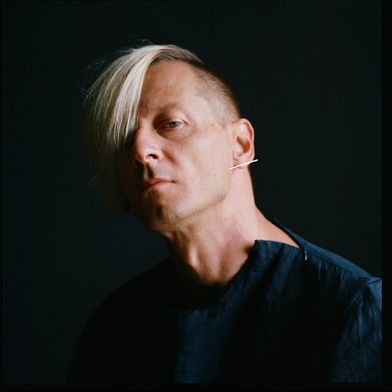
Image Description: Image shows the author of the article, a fair-skinned male with light blond
hair wearing a dark top against a black background. Photo by Maria Baranova.
Ivan Talijancic is a queer immigrant time-based artist and cultural producer, working at the intersection of theater, dance, film, installation art, new media, journalism, curatorial work and education in New York and around the globe. As a co-founder of the multidisciplinary art group WaxFactory, his work has been presented at numerous venues and festivals stateside and worldwide, including Lincoln Center (NYC,) ICA/Institute of Contemporary Art (London), Centre Pompidou (Paris), Gulbenkian Museum (Lisbon), Zürcher Theater Spektakel (Switzerland), Sonar (Barcelona,) Cankarjev Dom (Slovenia,) Adelaide Festival (Australia,)among others.
He has been awarded fellowships and residencies at Akademie Schloss Solitude
(Stuttgart, Germany,) Bogliasco Foundation (Genova, Italy,) Emily Harvey Foundation (Venice, Italy,) Hermitage Artist Retreat (Manasota Key, Florida,) Marble House Project (Vermont) and elsewhere. As a journalist, he regularly contributes to publications as BOMB Magazine, Brooklyn Rail, etc, and is a current member of the selection committee for The Bessies / the NY Dance & Performance Awards. Ivan teaches extensively in the US and abroad. He is the founder of CPP/Contemporary Performance Practices summer intensive in Croatia and is currently a professor at Carnegie Mellon University’s John Wells Directing Program. He holds an MFA from Columbia University School of the Arts.
@waxfactory.nyc
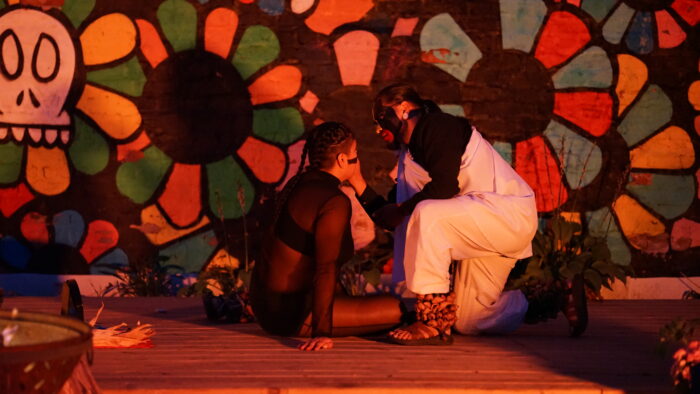
Image Description: Marcela Torres in all black sits on a wood deck in front of Izayo Mazehualli with a painted face. The man is wearing white pants and a robe. Mazehualli black lines across the other person’s face. Behind Torres and Mazehualli is a mural of flowers. Photo taken by Alejandro Reyes
Iyapokatzin; the venerable tobacco smoke, is a collaborative joining of bodily research and desires for a ceremony by Izayo Mazehualli and Marcela Torres. Together Mazehualli and Torres reflect on Mexican Toltec knowledge and Azteka-Chichimeka dance forms, then traverse into Folklorico movement in relation to Revolutionary-era traditionalism. The temporal space we create calls in our natural ancestors who help nourish us: tobacco, fire and smoke. Iyapokatzin; the venerable tobacco smoke premiered over three performances from September-October 2022. Two performances took place in Chicago at El Paseo Community Garden in Pilsen and the Malinalli Garden, a renovated garden in Little Village supported by Mas Maiz Native Land Project and Universidad Popular. A third performance occurred at Franconia Sculpture Park in Minneapolis.
Torres: The initial intention of this performance was to share a parallel narrative between our tobacco ancestral kin, known Toltec knowledge, and Latinx culture. Tobacco has had a role in ideas of protection, celebration, and political movements from pre-Columbian times to contemporary Latin America. Following my tobacco curiosity led me to a Danza Azteca community and an ancestral deity named Tezkatlipoka. Collective ceremony-making, cultural dance practices, and smoke rituals emerged from my tobacco research.
More than a performance, the series of Indigenous movements included in Iyapokatzin are part of a spiritual tradition that has its origin within the Nahua communities of central Mexico. Danza Azteca, as it’s known in Spanish, or Mitotilliztli in Nahuatl, is part of a centuries-old tradition that some claim is of pre-Hispanic origin. Brought over to the US by Mexican immigrants, the dance practice has been a part of the Indigenous resistance against Spanish colonialism and as a tool for cultural revitalization in both countries. Mitotilliztli is traditionally accompanied by the rhythm of the wewetl, or drum, with each dance contextualized in a ritual for particular purposes. It is essentially an offering to the Teteoh or forces of nature, a prayer for communal well-being, an act that expresses gratitude, and a symbolic language expressed through movement that conveys ancient knowledge about the cosmos, natural world, and human psyche.
Mazehualli: When I met Marcela in the summer of 2021, I was teaching Danza Azteca and conducting ceremonies in Chicago with a group I had founded centered around LGBTQ community members interested in ancestral Mexican practices. Before then, I had spent over ten years learning from elders and teachers, being initiated into the Toltec disciplines where I learned the rites of passage, rituals, dances, songs, philosophy, and martial arts system. Marcela shared their research on tobacco and the power of smoke, while inquiring about learning the dance forms related to these specific topics. I quickly related these ideas to the Nahua deity Tezkatlipoka, the smoke that emanates from the mirror; the mysterious deity related to the night, darkness, and the human psyche. Marcela respectfully asked to learn the dances of the Teteoh, and we proceeded to practice during a span of approximately one year. The process led to the creation of a ritualistic choreography that extended beyond the initial task of just learning the forms. In turn, a collaboration was established to create the telling of a story of initiation for a person’s preparation of ixiptla, or deity embodiment of Tezkatlipoka and the power of the tobacco smoke.
Torres: Tobacco holds ancestral protection. The ingestion of tobacco, whether it be through paste, salts, cigars, powders, or juices, is a way to enter into an altered form. In telling this story of tobacco, it had to be in ceremony with dance and to reach our ancestors and the messages they are sending us. Each cigar contains a unique blend of tobacco that evokes vivid phenomena through the unraveling of stories. I imagine the tropical fields with the tobacco lined up for harvest, then each one hanging to dry. Once the leaves are fermented, they are brought into a shared space where a community rolls them into cigars together. I laugh to myself thinking about the chisme that occurred during the rolling. Tasting blends of earthiness, damp trees, sweet graham cracker notes, or other surprising flavors arise with each inhale. In the past seven years, cigars have become a personal way to slow down, honoring the cadence of my breath, and reflecting on the terrain and its natural botany of my ancestry.
The tobacco woman is considered the mother of culture to the Witoto people in South America. Tobacco women taught humans to cultivate the land and become agriculturally sufficient. Her menstrual blood, represented as tobacco paste, warded off evil spirits who took on the bodies of wild forest animals. A common practice in the Amazon is to wash newborn babies while burning tobacco so they can use the memory of that smell throughout their life to recall moments of familial care. Additionally, in Central America after war and bloodshed, tobacco was planted to spiritually remediate ground, exhuming the spirits of those who were killed, allowing them to move to their next life. The tobacco strength as a companion plant, hallucinogen, and vibrant scent is why it resonates as such a powerful entity to so many groups.
Mazehualli: As the representative of Ketzalkoatl, carrier of knowledge, I set the tone of the ritual with the elaboration of an altar in front of the fire, placing the symbols of the four cardinal directions while singing a chant dedicated to Ipalnemowani, the giver of life. The last item placed in the altar that represents the northern direction of Miktlampa, place of death, is the obsidian mirror, Itztezkatl, associated with Tezkatlipoka. This last item is one of the focal points of the whole ritual, since it is the portal through which the person being initiated connects with Tezkatlipoka and their subconscious.
Placed in chronological order, the Azteka-Chichimeka dances Tletl (fire), Tezkatlipoka (smoking mirror), and Nextli (ashes), speak of the integration of the shadow from its inception with fire, then from fire to smoke, and finally smoke to ash. The Tletl dance has fast-paced steps that personify the movement of the fire, up and down, then side to side, continuously flowing in an intense stamina-required cardio sequence. Tezkatlipoka follows as the second dance, with its trance-like rhythm that includes steps in the form of spirals, crooked steps, and squats that symbolize the journey to the inner self. Nextli is the last of the three Danzas that I dance on my own, symbolizing complete burn-out; it is the chaotic and dramatic end that extinguishes the flame, returning to the carbon state that leads to integration back to the earth.
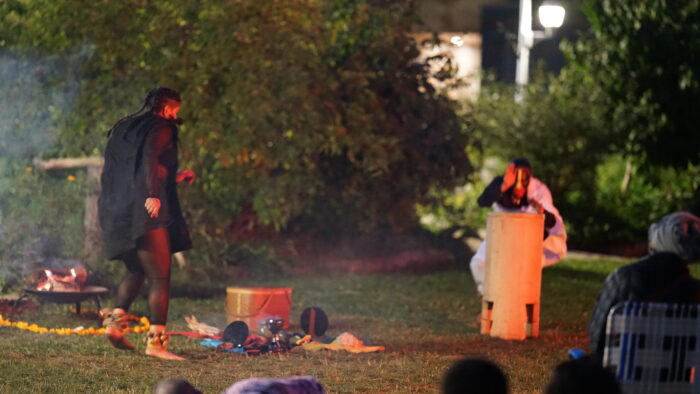
Image Description: Torres and Mazehualli are In a garden at night. Torres is dressed in all black dancing. Mazehualli is dressed in white robes and black shirt playing a drum. Behind them is a fire and altar space. Photo taken by Alejandro Reyes
Mazehualli: The sequence of events in the ritual were intentional, unfolding as Marcela is guided by Ketzalkoatl through the various stages of the initiation process. From being blindfolded when entering, to self-reflection in the obsidian mirror, and then blood offerings on paper, Marcela is instructed to access the subconscious mind where all of our fears, doubts, and memories reside. There are moments of chaos that lead Marcela into a frenzy that is expressed with the breaking of ceramic pieces and burning of paper offerings. Then there are moments of clarity, assisted with the cleansing of the space with copal smoke, the setting of the intention with the tobacco, and the offering of orderly dance sequences.
Torres: Once the drum ends and we have offered the second danza of Tezkatlipoka, the ceremony changes sentiments. I move away from the altar space built by Mazehualli. By removing the tilmahtli, a black textile that is tied around the body with a knot on the shoulder, which identifies me as Tezkatlipoka, I exit embodying Tezkatlipoka. I change into a custom black transparent Folklorico double-circle skirt and heels. From a table, I roll a cigar. The cigar is made out of tobacco leaves labeled by their tone and intensity of flavor and connected to places usually Mexico, South America, Caribbean and parts of Florida; a plot of land, and occasionally a family who cultivated it. A hand-rolled cigar is made of three parts. First, filler is made from a bundle of folded tobacco leaves. Then a binder leaf envelopes the filler. The most beautiful leaves are designated as the wrapper, and are the final smooth layer. In a single cigar, each part can come from a different leaf and location. Together they make one blend of many locations: a Nicaraguan filler finished with a Dominican wrapper, similar to the blended cultures people represent. Hand rolling cigars is an art form, a skilled rollers can handle and cut the leaves with their chaveta (a crescent-shaped piece of steel used by a cigar roller in a cigar factory to cut or smooth a wrapper leaf) into the perfect lines that will fold into gentle envelopes and be the correct thickness.
Folklorico is a dance form that emerged after the Mexican Revolution. It was a response from the Mestizaje to dictate norms of gender and formality as a newly reinstated Mexican culture. I combine Folklorico techniques with the industrialization of cigars as a gesture to consider colonial systems on the body in parallel with native plants undergoing similar stresses. I dance a series of chasing steps on a taima (i.e., wooden platform) beside the altar space. Mendoza-Garcia and I choreographed to follow the recording of a man rolling a cigar at the Casa Habano in Miami, Florida. Each smoothing and cutting action was assigned to a Folklorico step. The movements became a deconstructed, stripped down version that was more percussive than melodic.
The music transitions and, rather than just dancing Folklorico steps, I begin to improvise, into a combination of emotive movement play. The double-circle black mesh skirt becomes a veil, and the taima becomes also a place to lay. The logic of each dance form slip into a subconscious place. I’m recalling the industrial and goth clubs I learned to dance in. Their intensity of fast bpms, cavernous spaces that are pitch black but you are aware of yourself dancing so hard. You’re covered in sweat, and you feel it dripping down your back. You’re responding to each sound, allowing it to guide your body without comprehension. This also feels like transcendence, an overwhelming sensation of being in your subconscious, within Tezkatlipoka, the inner mind. This section ends with me smoking a cigar and having it drift through my skirt, connecting together all these disparate parts of my own diaspora story.
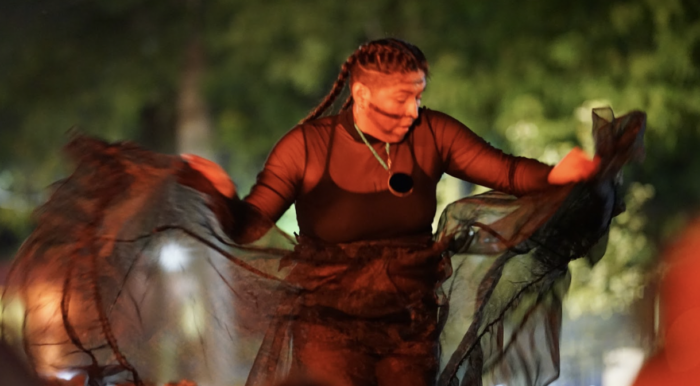
Image Description: Torres is front and center, wearing an all-black mesh shirt and dress. With both hands on the skirt, they wave it in action. The person wears an obsidian pendant and a necklace of jade. Photo taken by Alejandro Reyes

Image Description: Torres is in all-black mesh and is laying on the floor with their skirt over their face. We can see them looking up. Photo taken by Alejandro Reyes
Mazehualli: My research and experience led me to realize that the Nahua tradition is a living entity, opening a window for creativity that allows for a different interpretation of the ancestral knowledge. By viewing Mesoamerican deities under the lens of Jungian psychology, we can perceive them as archetypal figures for universal understanding of the natural world and its connection to the human psyche. Where Ketzalkoatl represents the wise man, conscious self, breath of life, and bearer of light and knowledge, Tezkatlipoka is the antithesis, the shadow, chaos, darkness, death, and carrier of our most profound fears. The constant theme throughout the ritual is one based in the principle of duality, Omeyotl, an ideological principle in Mesoamerican philosophy that reflects the eternal interplay between opposites that through integration and complementarity results in a new synthesis and creation.

Image Description: Mazehualli is kneeling at an altar. It has a ring of marigolds and other sacral items. His face is painted in black, yellow, and red. His hair in a neat ponytail. His right knee is up, and his left is on the ground. Photo taken by Alejandro Reyes
The focus of our collaborative work was not of decolonization and deconstruction of western thought, but rather, it was in the reclaiming of our ancestral Mexican wisdom. With thousands of years of philosophical evolution, the Toltec tradition offers a path that synchronizes us to the cycles of change with emphasis in duality and the integration of the shadow. Analysing traditional dance forms in order to queer them, bend them to evolve with us, we open a portal via the obsidian mirror, we offer tobacco smoke, and recognize our plant teacher to be the messenger that carries our intentions and prayers to the cosmic heart of the universe. Tezkatlipoka, as the mirror covered in smoke, is the unclear recollection of our memory; it is the collective unconscious that has stored our history from pre-Kwauhtemok times, through colonization, and up to our most recent past.
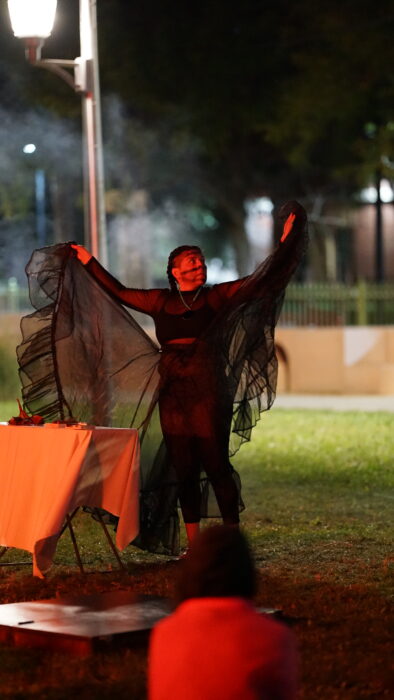
Image Description: Marcela Torres in all black mesh holds up the corner of their folkorico skirt into a large transparent fan. Photo taken by Alejandro Reyes
Born in Salt Lake City, Utah. Residing in a transitory journey between Utah, Illinois and New York. Torres received a BA in Sculpture Intermedia and a BFA in Art History from the University of Utah, continuing their studies in MFA in Performance form School of the Art Institute Chicago. Torres has performed at the Bemis Center for Contemporary Arts (Omaha, NE), The Momentary (Bentonville, AK), Fringe Festival (Detroit, MI), Experimental Actions (Houston, TX) and Time Based Arts (Portland, Oregon). Torres has exhibited work at Recess (Brooklyn, NY), Hyde Park Art Center (Chicago, IL) UW-Parkside University (Kenosha, WI) , Tropical Contemporary (Eugene, OR), Petzel Gallery (NYC, NY) In 2022 Torres is a Chicago Dance Maker Forum Lab Artist, a Art/Industry resident at John Michael Kohler Arts Center and a Fellow at Franconia Sculpture Park.
@_____marcelatorres______
Website
http://marcelaetorres.com
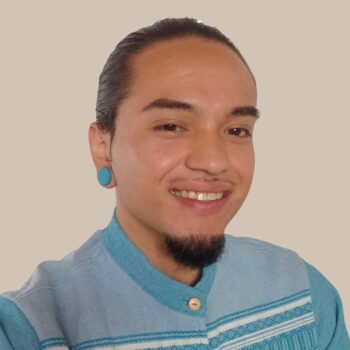
Image Description: A selfie by Izayo. Izayo Mazehualli–wearing a short-cropped beard, thin mustache, turquoise stone ear plugs, and a light-blue embroidered Zapotecan shirt– smiles at the camera with a friendly glint in the eyes.
Izayotilmahtli Mazehualli (Nahua / Purepecha), also known as Izayo, is an Indigenous/Chicanx cultural educator, dance instructor, martial artist, environmentalist, mental health advocate, and visual artist. He has spent over a decade learning from elders of the Mexican Nahua oral tradition, being initiated into several orders dedicated to the preservation of ancient disciplines like Yaotilistli (martial arts), Mihtotilistli (dance), and Kauhpowali (Toltec time-keeping). Based in Chicago, Mazehualli has been teaching movement classes and conducting Nahua ceremonies since 2017, both in-person and online. Mazehualli shares mindful movements to people of all ages and abilities, emphasizing the integration of mind and body to bring greater self- awareness and understanding of emotional, physical, and mental health. He frequently travels to Mexico where he conducts anthropological research on Indigenous cosmogony, dance tradition, and oral history.
Start from a place of self-care and you can accomplish so much. Don’t be afraid to say, “me first,” and then you can be available to do for others. All our learnings and then our teachings come much later, but for sure they come once you’ve committed to making space to receive. The path I’ve chosen includes a daily routine of self-care, being a student for life/activating my beginner’s mind and committing to paying it forward. I know you will build your own practice, but I’ve included some words from three Black women who I revere as my guides in this three-part telling –
“Self-Care” – bell hooks
“A Student for Life/A Beginner’s Mind” – Maya Angelou
“Paying it Forward” – Alice Walker
SELF CARE:
“Knowing how to be solitary is central to the art of loving. When we can be alone, we can be with others without using them as a means of escape.”— bell hooks
I have found that I must begin at the top of the day to give energy to myself. When I center myself, I can also give to others. So, every morning, as my feet touch the floor, I give thanks for the day and do whatever it is that I need to support this centering.
Consider this: Begin with a physical practice (yoga, walking, joining a group of movers), or make up words that can help center you and direct your day. Throughout your day, remind yourself how important you are. Repeat some of these physical activities, and say the words again and again. We all agree that nothing good has come from the onslaught of the pandemics, but we can all agree that being confronted with these many truths all at once has given us time to pause. Early in 2020, those of us who were used to sharing space and participating in activities with groups of people, were soon forced to isolate, but many of us found ways to be together. I created Black Dance Stories (BDS), the weekly online program where Black dance creatives gathered, as my call out to cultivate self-care. BDS filled my need to gather, but it also filled the need to support fellow Black creatives. We aired our final program in July 2021, but our BDS team remains determined to go forward with our mission as we always stated: We are a community working together to support, uphold, highlight, and celebrate Black Creatives.
I dare you: Find your isolation exercise, words that motivate, or something that makes you smile. Give yourself time to slowly build a practice of commitment. If you miss a day or two of your practice, or if your efforts don’t work out as well as you envisioned, don’t beat yourself up.
Do remember that self-care also means that you cannot beat yourself up if you missed a day or two, or if that thing didn’t quite work out as you envisioned it. There’s always another time, and time is on your side.
A STUDENT FOR LIFE/A BEGINNER’S MIND:
“As you grow older, you will discover that you have two hands, one for helping yourself, the other for helping others.”— Maya Angelou
At 61 years old, I am a student. I am reminded that it is okay to call forth your “beginner’s mind.” And also, over the years, I’ve learned that I must listen and learn from my mentors and my mentees.
Many years ago, when I worked at the Ailey School under the late Denise Jefferson, she gave me some sound advice that I replay as often as possible – she told me to always ask what it is that I’ve learned from every situation. This active listening helps me each day, and I call on it when complicated situations arise. In turn, I offer the same advice to mentees. Consider this: What if you replay something that you just learned, share it far and wide, and put it into action? What if you set aside time for receiving and making phone calls for/to mentors and mentees? What if you promise to just listen in the next check-in?
As a mentor or a mentee, whenever you can, spend time together in the same space, station yourself at each other’s feet, engage your active listening antennae and take lots of notes. It has been my practice to let these conversations find their own direction, but keep your goals in mind and keep the conversation on track. Most important, though, shower each other with love and support. Lift each other up!
I dare you: Don’t be afraid to approach someone you believe would be a good mentor for you. Have a chat about that possibility. If your chosen mentor agrees to work with you, commit to having frequent conversations with them.
PAYING IT FORWARD:
“Every small positive change we make in ourselves repays us in confidence in the future.”— Alice Walker
One of the things that brings me joy is making room for young Black creatives. Black Dance Stories has been the most recent platform for me to introduce Black creatives to the world, but I didn’t get here alone, and I will always make room for those who afford me the position to do so. From my dear friend and “brother” Rennie Harris, I’ve learned the importance of saying the names of those who stand by you. He has always mentioned me and thanked me, and I do the same. I know it’s also my charge to say the names of those who are coming up after us and show them support. It’s their turn now. We must assure a path and a place for each of them.
Consider this: I go to performances by dance artists who might be new to me but also performances where seasoned artists introduce new ones. I also seek out opportunities to introduce artists to other artists across generations and platforms. I never expect anything in return, but I do feel good to see my advice received. It takes flight in another form and gets passed on and on and on. I dare you: Fill your dance card with a list that represents an equal number of emerging and seasoned artists. Go see their rehearsals and performances as many times as possible. Make introductions across various platforms and encourage mentorship.
Sharing my practice with you here give me the charge to continue! Among the many mantras that I make up and repeat all day, every day, this one stands out:
“I will not hold anger, I will not pass judgment, I will ask for what I believe is right and just, I will find truth where it lies, and I will find peace in all that I do.”
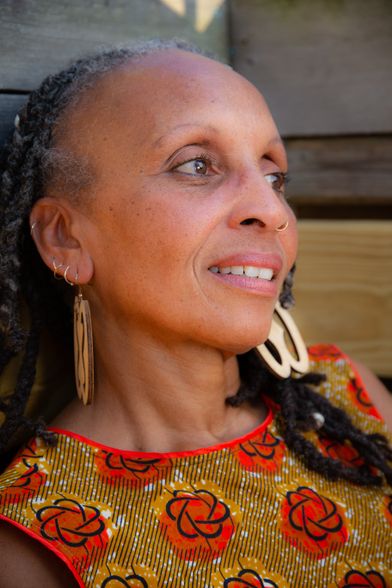
Image Description: Photo by Tony Turner. Dr. Warren leans back in this photo with her dreamy gaze towards the right edge of the image. She is a Black woman with a friendly smile, salt-and-pepper locks, and long, dangling earrings. She’s dressed in a sleeveless top with a pattern of large orangey-red rose over a dark-gold background.
Jamaican born, Charmaine Patricia Warren performer, historian, consultant, and dance writer, is the founder/artistic director for “Black Dance Stories” and “Dance on the Lawn: Montclair’s Dance Festival, “Producer of DanceAfrica, Artistic Associate and Programming Director at BAM. She is the Director of dance at The Wassaic Project, curated E-Moves at Harlem Stage and danced with david roussève/REALITY. Charmaine is on faculty at Empire State Colleges, a former faculty at Ailey/Fordham, Sarah Lawrence College, Hunter College and Kean University. She writes on dance for Amsterdam News and Dance Magazine and has served as a panelist for Robert Battle’s New Directions Choreography Lab. Charmaine holds a Ph.D. in History/Howard University, a Master’s in Dance Research/City College, and Bachelor Degrees (Dance/English)/Montclair State College. She received the 2020 Bessie “Angel” Award and a 2017 Bessie for “Outstanding Performance” as a member of Skeleton Architecture Collective.
Website
www.charmainewarren.com
Photo of Eva Yaa Asantewaa (she/her)
Image Description: In this selfie, taken in her home office,
Eva Yaa Asantewaa is wearing a black turtleneck sweater and
looking forward with a cheerful grin. She is a Black woman with luminous,
medium-dark skin and short gray hair. She’s positioned in front of a room
divider with an off-white basket-weave pattern.
Eva Yaa Asantewaa (she/her) is Editorial Director for Imagining: A Gibney Journal and, from 2018 through 2021, served as Gibney’s Senior Director of Curation. She won the 2017 Bessie Award for Outstanding Service to the Field of Dance as a veteran writer, curator and community educator. Since 1976, she has contributed writing on dance to Dance Magazine, The Village Voice, SoHo Weekly News, Gay City News, The Dance Enthusiast, Time Out New York and other publications and interviewed dance artists and advocates as host of two podcasts, Body and Soul and Serious Moonlight. She has blogged on the arts, with dance as a specialty, for InfiniteBody, and blogs on Tarot and other metaphysical subjects on hummingwitch.
Ms. Yaa Asantewaa joined the curatorial team for Danspace Project’s Platform 2016: Lost and Found and created the skeleton architecture, or the future of our worlds, an evening of group improvisation featuring 21 Black women and gender-nonconforming performers. Her cast was awarded a 2017 Bessie for Outstanding Performer. In 2018, Queer|Art established the Eva Yaa Asantewaa Grant for Queer Women(+) Dance Artists in her honor. In 2019, Yaa Asantewaa was a recipient of a BAX Arts & Artists in Progress Award. She is a member of the Dance/NYC Symposium Committee, Founding Director of Black Diaspora, and Founder of Black Curators in Dance and Performance.
A native New Yorker of Black Caribbean heritage, Eva makes her home in the East Village with her wife, Deborah. Sadly, their best-cat-ever Crystal traveled over the Rainbow Bridge on February 18, 2021.
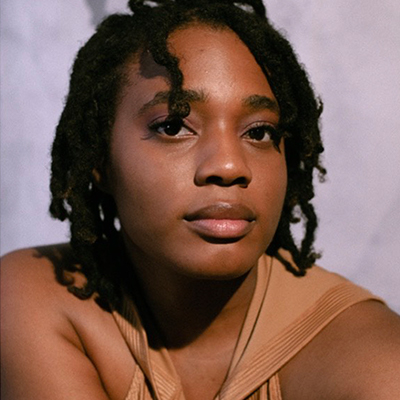
Photo of Monica Nyenkan by Jakob Tillman
Image Description: Monica Nyenkan is the daughter
of African immigrants. She has dark brown eyes and hair.
In this photo, her hair has two-strand twists.
Monica Nyenkan (flexible pronouns) is a Black queer artist, administrator, and emerging curator from Charlotte, NC. Graduating from Marymount Manhattan College, Monica received her Bachelor’s degree in Interdisciplinary Studies, concentrating on administration for the visual & performing arts.
Currently based in Brooklyn, Monica has interned and worked with Rachel Uffner Gallery, Gallim Dance, Ballet Tech Foundation, Movement Research, and 651 ARTS. She’s produced community-based engagements and art events throughout NYC for the last five years. She acted as a consultant and advisor to an award-winning project, LINKt: a dance film. Most notably, Monica co-curated WANGARI, a pop-up art exhibition focusing on climate change, with the Brooklyn-based collective Womanist Action Network.
Monica currently works as the Gibney Center Special Projects Manager, managing programs such as Black Diaspora and Imagining Digital. In her free time, Monica loves to watch horror films and spend time with friends and family.
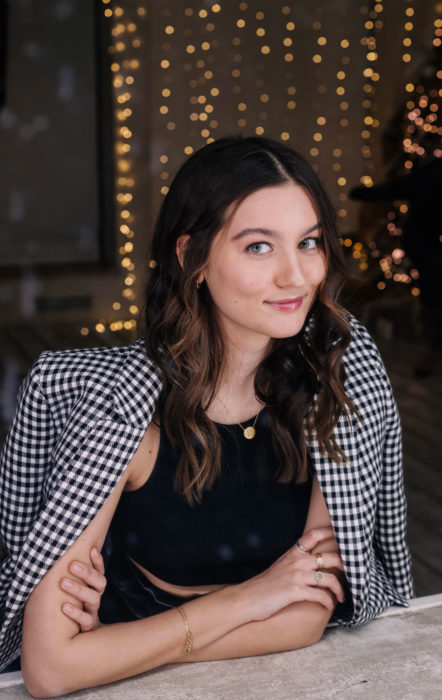
Photo of Anastasia Gudkova by Ksenia Ugolnikova. Anastasia is wearing a black top with a checkered blazer draped over her shoulders. She is a white woman with dark brown hair, wearing gold jewelry and light makeup. She is sitting down, leaning over a table with her arms crossed, and smiling into the camera. There’re string lights in the background of the photo.
Anastasia Gudkova (she/her), born in Moscow, Russia, is currently pursuing a B.A. in philosophy at New York University. While not a dancer herself, Anastasia has a deep passion and appreciation for contemporary dance and cultural programming and is fully dedicated to a future career in this sector.
Since 2019, Anastasia has worked as a Programming Assistant at MART Foundation, a non-profit, non-governmental foundation that supports contemporary culture on the international stage. Through this position, she has been exposed to a number of aspects of the performing arts world. Having worked on multiple projects both in the U.S. and internationally, Anastasia has been providing executive administrative assistance, events producing support, and logistics management.
Currently based in Brooklyn, Anastasia is a Gibney Center Presenting Intern since May 2022.
